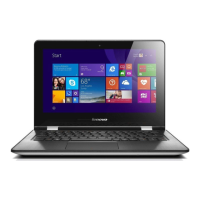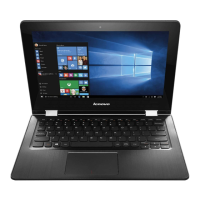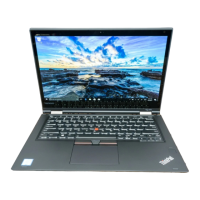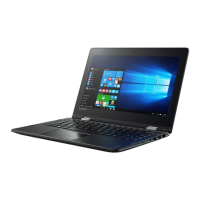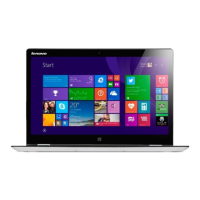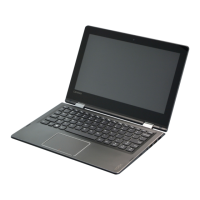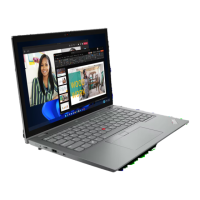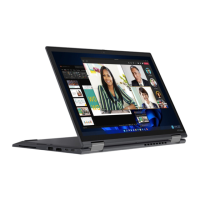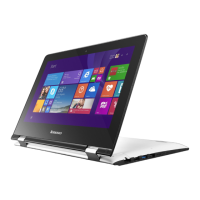
Do you have a question about the Lenovo Yoga 300-11IBR and is the answer not in the manual?
| Graphics | Intel HD Graphics |
|---|---|
| Operating System | Windows 10 Home |
| Weight | 1.39 kg (3.06 lbs) |
| RAM | 2GB / 4GB DDR3L 1600MHz |
| Storage | 500GB HDD |
| Display | 11.6-inch HD (1366 x 768) IPS |
| Battery | 30Wh |
| Dimensions | 299 mm x 209 mm x 21.6 mm (11.77 x 8.23 x 0.85 in) |
Identifies and describes the components visible on the top of the computer.
Details the computer keyboard and its associated hotkey functions for system settings.
Explains how to use function key combinations for changing operational features.
Describes how to position the display panel, allowing for 360-degree rotation.
Details the suitability of notebook mode for tasks requiring a keyboard and mouse.
Explains Stand Mode for tasks with little or no touch interaction.
Details Tablet Mode for tasks requiring frequent screen touch interaction.
Describes Tent Mode for tasks requiring limited touch screen interaction.
Identifies and describes the ports and features located on the left side of the computer.
Explains the function of the rotation lock button for screen orientation.
Details the buttons used to adjust the computer's volume levels.
Details how to rotate the display panel and prevent automatic orientation changes.
Guides on how to connect USB devices and manage drivers.
Explains how to insert and remove supported memory card types.
Identifies and describes the ports and indicators on the right side of the computer.
Describes the Novo button for accessing system recovery or BIOS setup.
Details the HDMI and RJ-45 ports on the right side for connectivity.
Provides instructions on how to connect an Ethernet cable to the RJ-45 port.
Identifies and describes the speakers located on the bottom of the computer.
Steps for initial setup of the operating system, including license, connection, and user account.
Explains the Start screen and Windows desktop interfaces and how to switch between them.
Details the navigation buttons (charms) for controlling Windows 8.1 features.
Explains the Search charm for finding settings, files, web content, and more.
Describes the Share charm for sending links, photos, and content to others.
Details the Start charm for quick access to the Start screen.
Explains the Devices charm for connecting and sending files to external devices.
Details the Settings charm for performing basic tasks like adjusting volume or shutting down.
Guides on how to put the computer to sleep or shut it down.
Details how to use the touch screen for input.
Explains touch gestures like tap and press and hold for various tasks.
Details touch gestures for zooming, rotating objects, and sliding/panning.
Explains swipe gestures from screen edges for app management and navigation.
Guides on enabling wireless functions and connecting to available networks.
Explains how to access Windows Help and Support files and online resources.
Instructions for creating a system backup image to restore the partition.
Guides on restoring the system partition to its original status or a previous backup.
Addresses common questions regarding setup, warranty, and preinstalled software.
Guides on finding safety precautions, support website, and warranty information.
Explains what preinstalled operating systems and software are and their licensing.
Explains how to check if the Windows copy was preinstalled by Lenovo.
Details the purpose and function of the Recovery Partition for system restoration.
Warns about the risks of deleting or modifying the Recovery Partition.
Guides on how to check if the Windows installation is WIMBoot enabled.
Explains where to find and download necessary hardware drivers.
Addresses common issues and questions related to the OneKey Recovery system.
Explains the purpose and access to the BIOS setup utility.
Provides solutions for common display issues like blank screens.
Addresses issues related to the computer entering sleep mode or low-battery warnings.
Solutions for when the computer fails to resume from sleep mode.
Troubleshooting tips for screen issues like blank, unreadable, or distorted displays.
Solutions for audio issues, such as no sound from speakers.
Addresses issues related to battery shutdown or operation.
Covers issues like computer unresponsiveness and external device problems.
